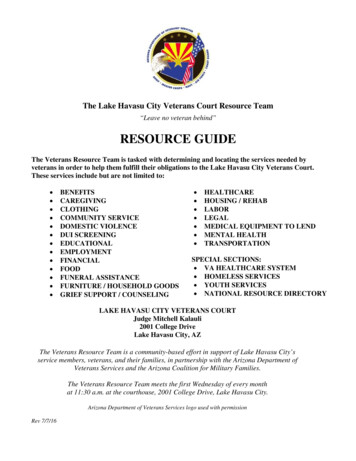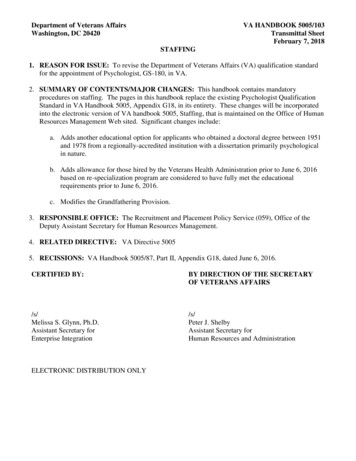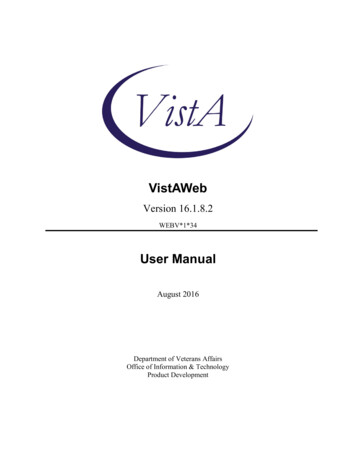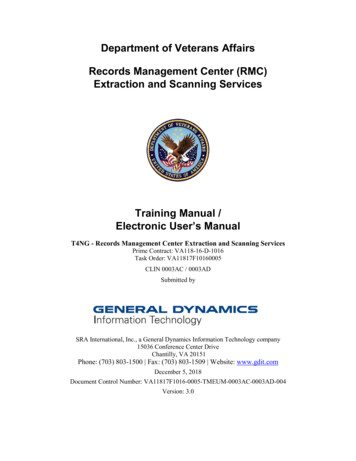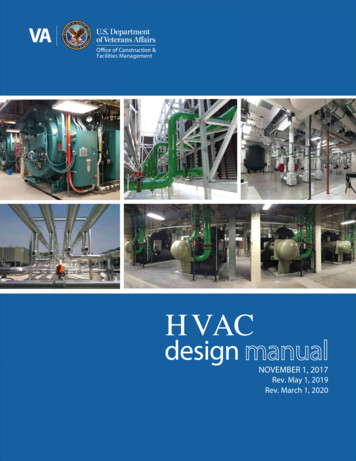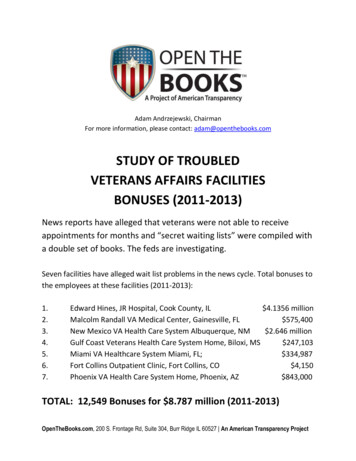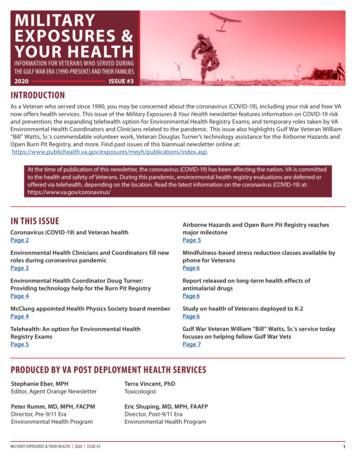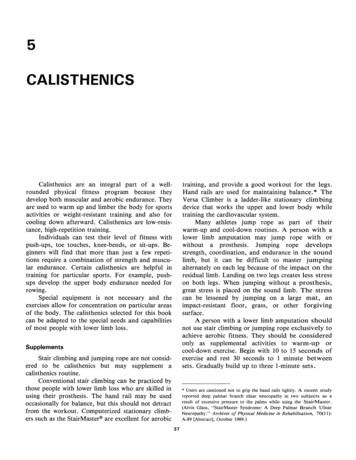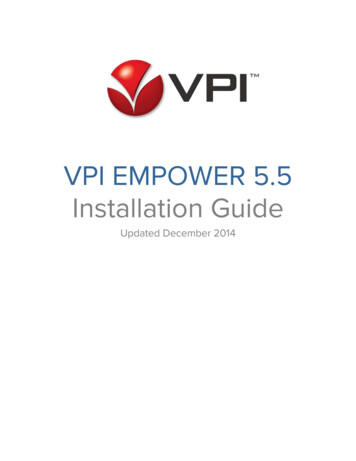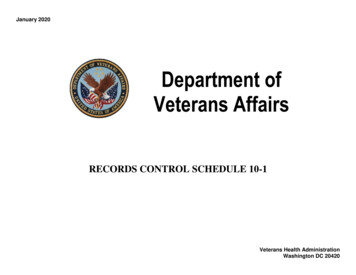
Transcription
January 2020Department ofVeterans AffairsRECORDS CONTROL SCHEDULE 10-1Veterans Health AdministrationWashington DC 20420
January 2020VHA Records Control Schedule 10-11. PURPOSEThe Records Control Schedule (RCS) 10-1 provides Veterans Health Administration (VHA) records retention and disposition requirements forVHA Central Office, Program Offices, and field facilities. The primary purpose of this revision is to incorporate changes to RCS 10-1 issued sincethe last publication date of January 2019. The schedule is divided into eight chapters. Each chapter covers a group of records, e.g., chapter onecovers administrative records. The first four chapters include most of the National Archives and Records Administration (NARA) GeneralRecords Schedules (GRS). Space for additional records schedules is available to allow for future expansion. The VHA Records ManagementOffice intends to update this schedule every three years in order to publish the most up to date records management requirements. Betweenupdates the VHA Records Management Office will post new or revised schedules on the HIM/RM (Health Information Management/RecordsManagement) website. Schedules are not required to be in the RCS 10-1 to be a legal schedule. Once a schedule is approved by the Archivist ofthe United States it must be used to manage the agency’s records.2. INTRODUCTIONa. Title 44, Section 3301, of the United States (U.S.) Code defines records as “all books, papers, maps, photographs, machine-readable materialsor other documentary materials, regardless of the physical form or characteristics, made or received by an agency of the U.S. Government underFederal law or in connection with the transaction of public business and preserved or appropriate for preservation by that agency or itslegitimate successor as evidence of the organization, functions, policies decisions, procedures, operations, or other activities of the governmentor because of the information value of data in them. Library and museum material made or acquired and preserved solely for reference orexhibition purposes, extra copies of documents preserved only for convenience or reference, and stocks of publications and of processeddocuments are not included. These items are referred to as non-record materials.b. The VHA Records Control Schedule (RCS) 10-1 is the main authority for the retention and disposition requirements of VHA records. Itprovides a brief description of the records and states the retention period and disposition requirements. It also provides the NARA dispositionauthorities or the GRS authorities, whichever is appropriate for the records, in addition to program and service sections.c. The GRS provides disposal authorities for temporary administrative records common to all Federal agencies. It covers records relating to:personnel, budget and finance, procurement, information technology, and other common functions and activities of Federal agencies. Anydeviation from the GRS must be authorized by NARA in accordance with 36 Code of Federal Regulations (CFR) 1228.42(B). Requests fordeviations from either the RCS 10-1 or GRS retention and disposition requirements are to be submitted to the VHA Records Management Officevia the Facility requesting the change and the primary VHA Program Office with authority over the record type that is being requested forchange.1
January 20203. RECORDS MANAGEMENT RESPONSIBILITIESa. The Assistant Deputy Under Secretary for Informatics and Analytics (10P2), Executive Director Information Governance (10P2C) HealthInformation Management/Records Management Office will be referred to as the VHA Records Management Office throughout this document.The VHA Records Management Office is responsible for developing policies and procedures for effective and efficient records managementthroughout VHA including VHA Program Offices and Veterans Administration (VA) Medical Centers. In addition, the Office acts as the liaisonbetween VHA and NARA on issues pertaining to records management practices and procedures.b. VHA Field/Facility Records Managers are responsible for all records management activities at their site.c. All VHA employees are responsible for ensuring that records are created, maintained, protected, and dispositioned in accordance with NARAregulations and VA policies and procedures.4. DISPOSITION OF RECORDSThe RCS 10-1 contains retention and disposition requirements for VHA records authorized by NARA or assigned a GRS authority. Recorddisposition refers to the transfer of records to an approved records storage facility, transfer of permanent records to NARA, the destruction ofrecords, or other appropriate actions to dispose of records. Unless retrieved; records transferred to a storage facility shall be dispositioned afterexpiration of their retention requirements.5. PERMANENT AND UNSCHEDULED RECORDSPermanent and unscheduled records in VHA custody must be reported through the VHA Records Management Office to NARA. Permanent(archival) records are defined as records appraised by NARA to have sufficient historical value or other value to warrant permanent preservationat the NARA. Un-appraised and unscheduled records are records that have not been evaluated to determine their record retention ordisposition. Such records are to be retained until they receive disposition authority from NARA. The VHA Program Offices responsible forunscheduled records shall work with the Field/Facility Records Manager, VHA Records Management Office and the VHA Records Officer toidentify, describe and submit to NARA a request for disposition authority using the NARA electronic Records Archives (ERA) system.6. MEDIA NEUTRAL RECORDSa. A media neutral schedule item on a records disposition schedule (i.e., SF 115, Request for Records Disposition Authority or NARA ElectronicRecords Archives (ERA) records scheduling module) applies to the described records regardless of their medium. Program Offices must submit anew schedule request through the VHA Records Management Office to NARA for approval of electronic versions of previously scheduled recordsif:2
January 2020(1) The content and function of the records have changed significantly (e.g., the electronic records contain information that is substantiallydifferent from the information included in the hard copy series or are used for different purposes).(2) The previously approved schedule explicitly excluded electronic records.(3) The electronic records consist of program records maintained on an agency Web site.(4) The electronic records consist of temporary program records maintained in a format other than scanned image AND the previously approvedschedule is not media neutral.b. Temporary still pictures, sound recordings, motion picture film, and video recordings. Apply the previously approved schedule to digitalversions.c. Scanned images of temporary records, including temporary program records. Apply the previously approved schedule.d. Other temporary records maintained in an electronic format other than scanned images:(1) For temporary records that are covered by an item in the GRS (other than those GRS items that exclude electronic master files anddatabases) or an agency-specific schedule that pertains to administrative housekeeping activities, apply the previously approved schedule. Ifthe electronic records consist of information drawn from multiple hard copy series, apply the previously approved schedule item with thelongest retention period. This is common when creating an electronic system that replaces a number of paper and electronic record types. Theolder systems and paper records are now placed into a new system. In the past these records may have covered various disposition life cycles.In the case of finance records the range could have been from one to six years. If the records in the new electronic system cannot bedispositioned separately then they must be kept for the longest disposition, in this case six years.(2) For temporary program records covered by a NARA-approved media neutral schedule item (i.e., the item appears on a schedule submitted toNARA for approval before December 17, 2007, that is explicitly stated to be media neutral, or it appears on a schedule submitted to NARA forapproval on or after December 17, 2007, that is not explicitly limited to a specific recordkeeping medium), are considered media neutral. Anexample of this is the Health Records Folder File or Consolidated Health Record (CHR). The original NARA approved records disposition schedulewas NARA (Job No. N1-15-91-6 item 1). This schedule was written and approved in 1991 and was for the paper health record only. In 2000(VHA) created an “Electronic Health Record”. Since this record was not paper VHA was required to submit to NARA a request for an electronicrecord schedule NARA (Job No. N1-15-02-3). This records schedule was created in 2002 which makes both the paper and electronic healthrecord media neutral for future changes.3
January 20207. DAMAGE TO AND UNAUTHORIZED DESTRUCTION OF RECORDSa. VHA records shall not be disposed of without the proper authorization to do so. Federal law prohibits unauthorized destruction or mutilationof Federal records. The penalty for such acts is a 2,000 fine, 3 years in prison, or both pursuant to Title 18 United States Code 2071. Damageto, and unauthorized destruction of records is to be reported to the VHA Records Office immediately upon knowledge of such an act ofdestruction.b. VHA officials must take measures to ensure that records are not disposed of improperly. Records are not to be removed from VHA custody ordestroyed without regard to the requirements of this schedule or the GRS. When records are improperly disposed, NARA regulations and VApolicy require the submission of a report to NARA. The report must include the record description, volume, date of incident, etc. Specificreporting requirements are contained in NARA regulations, Title 36, Code of Federal Regulations, Part 1228, Disposition of Federal Records, andVA Handbook 6300.1, Chapter 6., Records Management Procedures.8. RECORDS FREEZES/LITIGATION HOLDSa. Records freeze: Records whose scheduled disposition has been temporarily suspended because of special circumstances that alter theadministrative, legal, or fiscal value of the records.b. Litigation hold: The Office of General Counsel (OGC) may periodically issue a litigation hold or moratorium on the disposition of certainrecords because the records may be potentially responsive or helpful in ongoing or pending litigation (lawsuits).c. A "hold" is simply the implementation of a litigation hold notice issued by an OGC Office. Upon receipt, the records manager must suspendthe normal disposition cycle of the records listed in the hold notice to prevent their early/premature disposal. Holds are placed on records in anagency's physical custody.d. A "freeze" is created when the records manager receives a hold notice for records not in the agency’s physical custody but in the custody ofthe VA Records Center and Vault (RC&V), a Federal Record Center (FRC), or a commercial records storage facility. The Facility Records Managerwould ask NARA to create a freeze to halt premature disposition of the records. Since most litigations deal with relatively current agencyactivity, the number of freezes is significantly smaller than the number of holds since the agency still has physical custody of most recordsaffected by holds.e. Upon receipt of a hold notice the records manager should initiate a freeze on any off-site records in conjunction with the hold placed on theon-site records in physical custody. This ensures that any potentially responsive record is preserved regardless of its physical location.f. The Office of General Counsel maintains a list of litigation holds at the following website: OGC Litigation Share on/Lists/active/AllItems.aspx.g. Additional information may be found at the following NARA website: http://www.archives.gov/frc/arcis/freeze-faq.pdf.4
January 20209. ESSENTIAL RECORDSEssential records are defined as essential records needed to maintain the continuity of Federal government activities during and following anational emergency or a technological or natural disaster and to protect the rights and interests of VA beneficiaries and employees. Additionalinformation can be found in VA Handbook 6300.2.10. PERSONAL PAPERSPersonal papers consist of documents that relate only to an individual’s personal affairs and do not affect the conduct of government business.Examples of personal papers are diaries, journals or other personal notes that are not created in the process of transacting governmentbusiness. Personal papers may be disposed of in accordance with the owner’s preference. Note: Personal notes included on an official calendaror files are subject to official records authorities.11. TERMINATION OF OFFICE/SERVICE AND DEACTIVATION OF FIELD FACILITYa. Specific records management procedures are to be followed when terminating an office/service or deactivating a field facility. Theprocedures are contained in VA Handbook 6300.1. It is important to follow these procedures to prevent the loss or unauthorized destruction ofVHA records.b. Once it has been determined to abolish an office/service or to deactivate a field facility, the office or facility records manager is to beconsulted so that certain measures are taken to prevent the premature destruction of records. An evaluation is to be conducted to determinethose records that are eligible for immediate destruction, identify records that are to be transferred to the successor office/service or facility,identify records that are eligible for transfer to a records storage facility, and identify records of permanent value to be offered to the NARA.Records are not to be disposed of without proper authority to do so.12. DEPARTMENT OF VETERANS AFFAIRS (VA) POLICYa. VA Directive 6300, Records and Information Management, provides the policy for records and information management.b. VA Handbook 6300.2, Management of the Vital Records Program, implements the VA Vital Records Program which is an integral componentof the VA Emergency Preparedness Plan.c. VA Handbook 6300.8, Procedures for Shipment of Records to the RC&V in Neosho, Missouri, provides procedures for transferring records tothe RC&V.d. VHA Directive 6300.01, Records Management Compliance Monitoring, provides compliance requirements for the Records ManagementProgram.5
January 2020Chapter 1- General Administration & Management Records1001- Common Offices’ RecordsThis schedule covers certain records common to most offices in Federal agencies, whether those offices are involved in administrative or mission-relatedactivities. Most of these records are administrative housekeeping records. Agencies create and maintain administrative records when carrying out general,non-mission-related activities that keep an office operating. In contrast, agencies create mission records when carrying out the unique activities for whichthe agency was established. The only mission-related records this schedule covers are non-recordkeeping copies of electronic records (item 020) that aremaintained for decision-making purposes or taking action. Copies maintained solely for convenience of reference are considered non-record materials. Thisschedule may be applied to records in offices that carry out mission-related activities, but only those records that are described here.This schedule does not apply to transitory records, which are scheduled in GRS 5.2. The distinction between transitory and the records covered in thisschedule is that the records here generally have a longer period of business use than transitory records. This schedule also does not cover materials anagency determines to be non-record or personal. Neither does this schedule cover common administrative records found in most offices that are scheduledelsewhere in the GRS, such as timekeeping and procurement records.ItemNumberRecords DescriptionAdministrative Records Maintained in Any Agency Office.1001.1Records accumulated by individual offices that relate to routine day-to-day administration and management ofthe office rather than the mission-specific activities for which the office exists. Includes: staff locators, unofficial organizational charts, and office seating charts (see Exclusion 1)office-level administrative policies and procedures and files related to their development (see Note 1)calendars or schedules of daily activities of non-high-level officials (high-level officials are defined inGRS 6.1; this item covers those positions not defined as high-level)informal requests and tracking of personnel training, travel, supplies, and equipment, excludingprocurement and payment records and forms requesting training (e.g. SF-182)internal office activity and workload reportsstudies and analyses of office administrative functions and activitiesnon-mission related management reviews and surveysminutes of meetings related to administrative activitiesDispositionInstructionsTemporary. Destroywhen business useceases.DispositionAuthorityGRS 5.1, item010DAA-GRS2016-00160001EXCLUSION: This item does not apply to recordkeeping copies of organizational charts, functional statements,and related records that document the mission-related organization, staffing, and procedures of the office.6
January 2020ItemNumberRecords DescriptionNon-recordkeeping Copies of Electronic Records.1001.2Non-recordkeeping copies of electronic records agencies maintain in email systems, computer hard drives ornetworks, web servers, or other locations after agencies copy the records to a recordkeeping system orotherwise preserve the recordkeeping version. Includes: documents such as letters, memoranda, reports, handbooks, directives, manuals, briefings, orpresentations created on office applications, including those in Portable Document Format (PDF) or itsequivalentsenders’ and recipients’ versions of electronic mail messages that meet the definition of Federalrecords, and any related attachmentselectronic spreadsheetsdigital still pictures or postersdigital video or audio filesdigital maps or architectural drawingscopies of the above electronic records maintained on websites or web servers, but EXCLUDING webpages themselvesDispositionInstructionsTemporary. Destroyimmediately aftercopying to arecordkeeping systemor otherwisepreserving, but longerretention is authorizedif required for businessuse.DispositionAuthorityGRS 5.1, item020Temporary. Destroywhen business NOTE 1: Non-recordkeeping copies may be Federal records. Often, copies are non-records and can beimmediately destroyed, but not always. Copies are non-record if they are kept only for convenience ofreference. If copies are used in the course of agency business to make decisions or take action, they areFederal records. The copies described here are Federal records if they are still being used by the agency forsuch business purposes but are not recordkeeping copies of those records.NOTE 2: For electronic mail records, the recordkeeping system must capture the names of sender andrecipients, date (transmission data for recordkeeping purposes), and any receipt data, along with the messagetext. Sender/recipient information should be individual account information, not the name of a distribution list.Records of Non-mission Related Internal Agency Committees.1001.3Records created and maintained by committees established by an agency for facilitative or operational purposesunrelated to the agency’s mission, such as organizing events, selecting interior furnishings, overseeingvolunteer activities, or employee recreational activities. Records include: meeting minutes, summaries, agendas, and transcripts reports and studies membership records correspondence, mailing, and distribution recor
Jul 03, 1995 · 10. PERSONAL PAPERS Personal papers consist of documents that relate only to an individual’s personal affairs and do not affect the conduct of government business. Examples of personal papers are diaries, journals or other personal notes that are not crea
